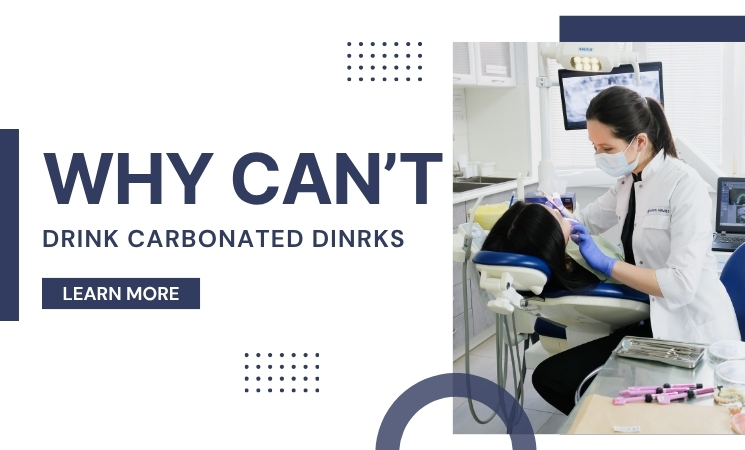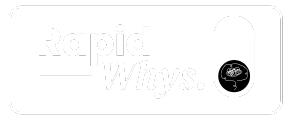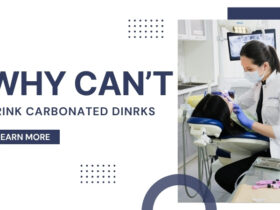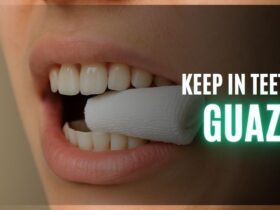Recovering from a tooth extraction is a delicate process that begins the moment the procedure ends. During this healing phase, grabbing a cold soda or fizzy drink might sound tempting—but doing so can actually cause more harm than good.
In this post, we’ll explain why carbonated drinks are a bad idea after a tooth extraction, what complications they can cause, and when it’s safe to enjoy them again.

Why Fizzy Drinks Are Risky After an Extraction?
When a tooth is removed, a blood clot naturally forms in the empty socket to protect the underlying bone and nerve endings. This clot plays a vital role in your recovery.
This section elucidates the reasons for which carbonated beverages can interfere with the healing process.
1. They Might Dislodge the Clot
When you drink soda or sparkling water, the fizz can create pressure in your mouth. This pressure might disturb or knock loose the protective blood clot, increasing the risk of a painful condition called dry socket.
2. Acidity Slows Down Healing
Most sodas and sparkling beverages contain acidic ingredients, like citric or phosphoric acid. These acids can irritate the sensitive tissue around the extraction site, making it harder for your gums to heal and increasing the chance of swelling or infection.
3. They May Prolong Bleeding
Because of their chemical content, fizzy drinks can interfere with the body’s natural clotting process, leading to continued bleeding in the extraction area.
Most people wonder how long to keep gauze after a tooth extraction. In most cases, gauze is only needed for the first 1 to 2 hours. If the bleeding is light or has stopped, it’s safe to stop using it.
4. Sugar Fuels Harmful Bacteria
Sweetened carbonated drinks provide a perfect environment for bacteria to thrive—especially in an open wound. This can lead to infections and further delay recovery.
When Is It Safe to Drink Soda Again?
Most dental professionals recommend avoiding carbonated drinks for at least 7 to 10 days after tooth extraction. However, healing times vary depending on:
- Whether the procedure was simple or surgical
- Your age and overall health
- How closely you follow post-operative instructions
To be sure, consult your oral surgeon or dentist before reintroducing fizzy beverages.
What Are Safer Alternatives?
Instead of soda, stick with non-carbonated, soothing drinks that won’t disrupt healing. Great options include:
- Plain water
- Chilled herbal teas, like chamomile or peppermint
- Milk or plant-based milks
- Coconut water
- Smoothies
What If You Drink Soda Too Soon?
Drinking carbonated beverages too early can lead to serious problems, such as:
- Dry socket – a painful condition caused by clot loss
- Infection – from sugar-fueled bacterial growth
- Inflamed gums – irritation from acidity
- Excess bleeding – especially within the first 48 hours
Even one soda can set you back if consumed during the critical early recovery window.
Tips for a Smooth Recovery
To avoid problems and encourage proper healing, follow these aftercare tips:
- Avoid straws – suction can pull out the clot
- Skip hot beverages – heat may increase bleeding
- Don’t smoke or vape – these can delay healing and dry out the socket
- Rest with your head elevated – reduces swelling
- Gently rinse with salt water after 24 hours to keep the area clean
Final Thoughts
While soda may appear innocuous, its consumption following a tooth extraction can lead to significant complications. To facilitate a smooth and comfortable recovery, it is advisable to completely abstain from carbonated beverages until the oral cavity has fully healed. Prioritize your health today—your smile will thank you tomorrow.

When Can I Brush After Tooth Extraction?
You can brush your teeth after a tooth extraction, but avoid the extraction site for the first 24 hours to prevent disturbing the blood clot.
Why Did I Get Stitches After Tooth Extraction?
You got stitches after tooth extraction to help control bleeding, close the wound, and promote faster, more effective healing of the gum tissue.
When Can You Drink Carbonated Drinks After Tooth Extraction?
You should wait at least 48–72 hours before drinking carbonated drinks after tooth extraction, as bubbles can disrupt healing and dislodge the blood clot.
Can You Have Carbonated Drinks After Wisdom Teeth Removal?
No, you should avoid carbonated drinks for at least 48–72 hours after wisdom teeth removal, as they can irritate the extraction site and delay healing.
Can I Eat Ice Cream After Tooth Extraction?
Yes, you can eat ice cream after tooth extraction, especially within the first 24 hours. Its cold temperature can help reduce swelling and soothe the area, but avoid cones, crunchy toppings, or very sweet varieties.
















Leave a Reply